Building demolished Spring 2012. See Centrepoint Development
Place: Clarendon Hotel / MTS Exhibition Hall (Website)
Address: 300 Portage Avenue (Map)
Opened: 1920
Architect: Carter-Halls-Aldinger
Background:
The first hotel on this site was the Cosmopolitan (renamed the Clarendon) that opened on May 1, 1880. In 1883 it burned to the ground and owner Fred McKenzie rebuilt bigger and better. The 150 room Clarendon Hotel, at five stories, certainly stood out along the relatively undeveloped Portage Avenue.
October 16, 1890, Brandon Weekly Sun
By 1890 the hotel changed hands and new owners George Rutley and P. McCaffrey made a number of renovations, including adding a Turkish Bath, to ensure that the Clarendon kept its reputation as a luxury hotel. From 1890 - 1904 owner Charles Bunnell continued the luxury tradition.The Clarendon began to face competition in the upscale hotel market with the Empire Hotel in 1905, Royal Alexandra in 1906, the McLaren Hotel in 1910 and the Olympia (now Marlborough) in 1914. It soon went into decline.
In the summer of 1920 F. W. Leistikow, vice president of the Capital Loan Company, took over the property but was not interested in running a hotel. Rumours of the new development ranged from a vaudeville theatre to a new Hudson's Bay Company store, (which was still located at Main and York at the time.)
June 4 1920, Winnipeg Free Press
Since the opening of Eaton's in 1906 (expanded in 1910) Portage began to transform into "...a great retail thoroughfare...." (June 4, 1920, Manitoba Free Press). Many small and medium sized properties were changing hands to make way for larger structures with a strong main floor retail component. Examples include the Paris Building (1915), Curry Building (1915) and Boyd Building (1916).In the end, Leistikow decided to develop the site for himself. The $147,000 Clarendon Building would be a modest affair in comparison to some of its recent neighbours. Two storeys with retail on the main floor and 11,000 sq ft of office space up top.
August 20, 1920, Winnipeg Free Press
October 29, 1920, Winnipeg Free Press
By the time the old hotel was demolished, an impressive lineup of retailers had already signed on. It included Winnipeg's ninth Liggett's Drug Store, O'Neill’s Furrier and the Ryan Devlin Shoe Company. In late November 1920 the retailers began to open.The second floor took longer to fill. Originally, an unnamed financial company was to take most of the space but that deal fell through. In early 1921 The Clarendon, a supper and dance club, opened.
In February 1923 a fire caused extensive damage to the block and it had underwent weeks of renovations.
May 17, 1931, Winnipeg Free Press
Filling that second floor continued to be a problem for Leistikow. In 1930 he announced that it would undergo extensive renovations to convert it into 60 hotel rooms. It opened in May 1931 as the Clarendon Hotel !circa 1977
Over the decades a number of well-known local retailers called the Clarendon Hotel's main floor home including: Genser's Furniture (1930s); Advance Electronics (1970s); the Imperial Bank Bank of Commerce (50's - 70s) and Book Fair (1980s).
The last owner of the Clarendon Hotel took over in 1987. Chuck Green, owner of the Osborne Village Inn, renovated the block and rechristened it the Portage Village Inn.
In 1999 A&B Sound, a B.C. based chain of music and electronics stores, purchased the block from the city and received a $835,000 heritage tax credit toward a $2.5m renovation to convert it into retail space. Renovations were completed but the chain soon began to falter and in 2005 declared bankruptcy and the store closed.
In the summer of 2010 True North, owners of the MTS Centre, announced that they purchased the building and would convert it into an exhibition hall. It opened on September 17, 2010 with Bodies: The Exhibit.
In June 2011 True North and CentreVenture announced that the site would be part of a new entertainment and retail district that would take up most of the block. The Clarendon Hotel is to be demolished and replaced with .... a hotel ! It will be fourth on the site since 1883 !
An historical tidbit: the west wall of the Clarendon Hotel building, abutting the Mitchell Copp / Bank of Commerce building, is part of the original 1883 structure, according to a Free Press story from 1920.
Related:
My Photo Gallery of 311 Portage
311 Portage Avenue Historic Buildings Committee Report
 311 Portage Colliers Sales Brochure
311 Portage Colliers Sales Brochure
UPDATE:
Demolition has begun West End Dumplings
Clarendon Hotel No. 3 (1921 - 2012.) Source.
As the fortunes of the downtown declined, so did the Clarendon's. In the 1960s it already had a reputation as a rough place.The last owner of the Clarendon Hotel took over in 1987. Chuck Green, owner of the Osborne Village Inn, renovated the block and rechristened it the Portage Village Inn.
April 7, 1988, Winnipeg Free Press
The 1980s changes included a new name for the bar: the C. F. Bunnell Beverage Emporium, a nod to the 1894 to 1904 owner. It featured live music and in 1988 attracted an up and coming Canadian band called the Tragically Hip ! Any renaissance was short lived, though. The hotel's seedy and criminal reputation made it a prime target for those wanting to clean up the Portage Avenue retail strip.June 18 1998, Winnipeg Free Press
Green claimed that he had purchased the hotel as a short-term investment but in the end was unable to sell it. On June 18, 1998 city council allocated $438,600 to purchase the block with the sole intention of shutting it down. It was a move welcomed by many, including the police who said they were "glad to see it go."In 1999 A&B Sound, a B.C. based chain of music and electronics stores, purchased the block from the city and received a $835,000 heritage tax credit toward a $2.5m renovation to convert it into retail space. Renovations were completed but the chain soon began to falter and in 2005 declared bankruptcy and the store closed.
In the summer of 2010 True North, owners of the MTS Centre, announced that they purchased the building and would convert it into an exhibition hall. It opened on September 17, 2010 with Bodies: The Exhibit.
In June 2011 True North and CentreVenture announced that the site would be part of a new entertainment and retail district that would take up most of the block. The Clarendon Hotel is to be demolished and replaced with .... a hotel ! It will be fourth on the site since 1883 !
An historical tidbit: the west wall of the Clarendon Hotel building, abutting the Mitchell Copp / Bank of Commerce building, is part of the original 1883 structure, according to a Free Press story from 1920.
Related:
My Photo Gallery of 311 Portage
311 Portage Avenue Historic Buildings Committee Report
 311 Portage Colliers Sales Brochure
311 Portage Colliers Sales BrochureUPDATE:
Demolition has begun West End Dumplings
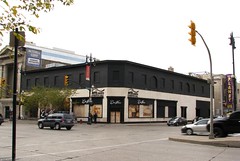
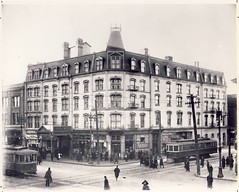










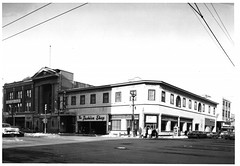



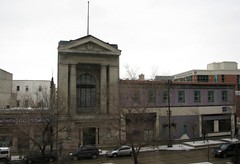
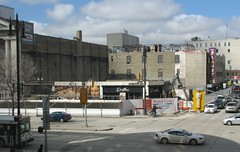
Great research here as always. I find it surprising that the 1920 iteration of this building wasn't a little grander given the extremely prominent location of the building (considering that it was right outside the doors of the most dominant retailer in Winnipeg history).
ReplyDeleteI thought so, too. Even the rumours about it were grand enough back in the day but nobody publicly criticized what was finally built.
ReplyDeletePerhaps, like with the Curry Building, the plan was to be able to add floors over time and it just never panned out.
I have nothing but fond memories of the building. I saw a number of great bands at The Junkyard in the early-tp-mid 90s.
ReplyDeleteI used to buy CDs at A&B Sound all the time. Was sad to see it go, as they had a great selection of the truly obscure music I prefer.
The old Clarendon had a dubious claim to fame as the place where Regina MP Nicholas Flood Davin killed himself in October, 1901 (see Dictionary of Canadian Biography online, http://www.biographi.ca/009004-119.01-e.php?id_nbr=6664). Among other things Davin wrote the 1879 repoort that led to the creation of Indian residential schools. Davin's career and personal life were in shambles when he came to Winnipeg hoping that premier Rodmond Roblin would give him a job. Roblin refused to see him and then, as Davin was returning to the hotel, he ran into his former lover who publicly trashed him on Portage Avenue. His first suicide attempt failed because his gun had the wrong size ammunition. He took the gun to Ashdown's Hardware for advice and the manager, alarmed by Davin's demeanor, confiscated it. Davin then went to another hardware store, bought another gun with the right ammunition, returned to the Clarendon and successfully shot himself. An unopened letter from his wife in Regina was found in his pocket.
ReplyDeleteI worked in thete for 15 years maybe more was creepy I'd walk along the top ceiling on the floor boards n I always sat in an area noone seemed to know of I use to be in every part of that place was cool basement gave me feeling I was watched
Delete